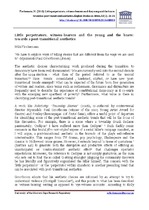| dc.contributor.author | Flockemann, Miki | |
| dc.date.accessioned | 2017-05-22T14:11:55Z | |
| dc.date.available | 2017-05-22T14:11:55Z | |
| dc.date.issued | 2010 | |
| dc.identifier.citation | Flockemann, M. (2010). Little perpetrators, witness-bearers and the young and the brave: towards a post-transitional aesthetics. English Studies in Africa, 53(1): 21-34 | en_US |
| dc.identifier.issn | 0013-8398 | |
| dc.identifier.uri | http://hdl.handle.net/10566/2863 | |
| dc.identifier.uri | http://dx.doi.org/10.1080/00138398.2010.488333 | |
| dc.description.abstract | The aesthetic choices characterizing work produced during the transition to democracy have
been well documented. We are currently well into the second decade after the 1994 election -
what then of the period referred to as the 'second transition'? Have trends consolidated,
hardened, shifted, or have new 'post-transitional' trends emerged? What can be expected of the
future 'born free' generation of writers and readers, since terms such as restlessness, dissonance
and disjuncture are frequently used to describe the experience of constitutional democracy as it
co-exists with the emerging new apartheid of poverty? Furthermore, what value is there in
identifying post-transitional aesthetic trends? | en_US |
| dc.language.iso | en | en_US |
| dc.publisher | Taylor & Francis | en_US |
| dc.rights | This is the author-version of the articled published online at: http://dx.doi.org/10.1080/00138398.2010.488333 | |
| dc.subject | Post-transitional | en_US |
| dc.subject | Aesthetics | en_US |
| dc.subject | Constitutional deomcracy | en_US |
| dc.subject | Apartheid | en_US |
| dc.title | Little perpetrators, witness-bearers and the young and the brave: towards a post-transitional aesthetics | en_US |
| dc.type | Article | en_US |
| dc.privacy.showsubmitter | FALSE | |
| dc.status.ispeerreviewed | TRUE | |
| dc.description.accreditation | DHET | en_US |

